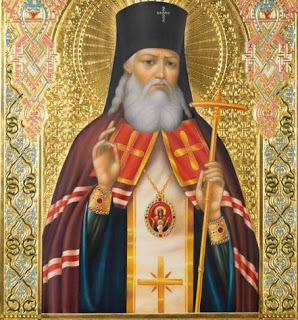By Zina Lysandros Panagidis, Philologist
This year I felt that I always had to fulfill my vow that I made in Agios Loukas the Doctor, three and a half years ago, when my mother fell ill and we took her to the hospital. So, since last Christmas we cut the tickets with the Ukrainian airlines, Aerosvits, we found the hotels we would stay for a week, and on July 1, 2012 we started from Larnaca airport to Kiev, the capital of Ukraine.
I was so eager to visit and worship the septic and miraculous relic of St. Luke, the miraculous doctor, that I defied the three-hour delay at Larnaca airport because the plane was late arriving from Ukraine. How could we know what awaited us in Kiev!
First of all, what I liked was the fact that we passed over the northeastern beaches of our island, and so, looking at them from above, I felt them as our own, our own. For the first time I realized perhaps how enchanting they are, as the plane flew away, passing over the sea of Cilicia, heading towards the Turkish coast, in the north of Cyprus. Twenty minutes passed from Larnaca until we reached the Turkish coast. I was emotionally charged, looking down on the Karpasia peninsula. And it was the magnificent time of sunset, the time when the sun was going to rest in its kingdoms, and painted the horizon with its golden-purple reflections. At one point I saw a bay, and I imagined it to be the bay of Davlos and above it the beloved Kandara with "the hundred houses of Reina". And below, perched on the Pentadaktylos, our villages with their Greek names: Flamoudi, Mantres, Gerani, Ardana.
Now from below, we see only rocky lands, deserts, somewhere a green suspicion emerges, a tiny settlement. It occurred to me that we may have passed over Cappadocia with those menacing rocks, abyssal ravines, unreal geological formations, churches and hermitages carved into the soft sandstone. Moreover, seeing the deserted areas below, my mind flashed to the Greek soldiers in 1922 in the Almyra desert and their unimaginable suffering.
After exactly forty minutes, we passed over the Black Sea. The third largest sea on the European continent, after the Mediterranean and the Baltic. Inhospitable sea, "Axenos Pontos" which, in order to appease the Greek sailors who sailed it, euphemistically called it "Black". What is the first thing that comes to mind, looking down on your beach? The flourishing Greek colonies that, as Plato (21) says, were all around Pontus, like frogs around the lake? Sinope, Amisos, Trabzon, Pantikapaio, Olbia, Phanagoria, Istria, Mesimvria, etc. Or the Argonaut campaign with "Argo" and the golden fleece in Colchis? Or, also, the Iphigenia that Orestes found in the land of the Bulls, where the goddess Artemis took her to bring her to a priestess in her temple? From the archeological findings, it seems that the area was inhabited in the 7th century BC. century. In fact, the founder of Sinope is considered to be Autolycus, a member of the Argonaut campaign. The northern part of Asia Minor, also called Pontus, hosted the empire of the Komnenians, who founded the empire of Trebizond.
It took fifty minutes for the plane to fly over the Black Sea or the Black Sea, and see the land of Crimea. Immediately, everything changed. Green land, mountain peaks and vast cultivated areas. And then came the big rivers with their tributaries. Three rivers flow into the Black Sea, which is so named because of the color of its waters, because compared to the Mediterranean it is not so blue. What we see must be the Dnieper River that crosses Kiev. Finally, after another fifty minutes over the Crimean peninsula and Ukraine, we landed at Kiev airport. The journey lasted two hours and forty minutes in total.
The joy of the wonderful trip to Kiev, however, was spread by the inconvenience reserved for us by the company that would take us to Simferopol, Crimea. It was also the final of the football championship (EURO), between Spain-Italy. All the fields inside the airport were full of planes that came for the race. Anyway, after a long delay, we finally arrived in Simferopol. It was a journey of one hour and five minutes. We are leaving, without formalities, since despite the independence of Crimea, in fact it belongs to Ukraine.
Outside the airport, icons of Christ, the Virgin Mary and other Saints. The long persecutions did not uproot from the soul of this people their great faith, while the human worldviews of materialism and atheism collapsed like a paper tower, like an avalanche. Eventually, Orthodoxy won, God returned to the land of Crimea.
Also outside the airport, women sell fresh, delicious and juicy fruit. We take a taxi and head to the Moscow Hotel. He asked us for 150 hryvnia, ie 15 euros. Normal price. The route outside the city is exquisite, fields drowned in green, large three-way boulevards crowned all around by tall trees. An openness everywhere, which opens and widens the soul. Our being with the flowered atmosphere rejoices.
Soon, however, we are drowned out by the misery and asceticism of apartment buildings of the Soviet era, false witnesses of the misery of this unfortunate people who, from the oppression of tsarism, fell into the throes of communism. Buildings unmaintained, unfortunate, screaming wear, lack of care, cancellation. Of course, the same picture prevails in other cities of the former Eastern bloc, but here it is more glaring. And here in the Crimea, what I once read is true: that all the communists in these countries had to show was what nature generously gave them and what the tsarist vanity left them.

